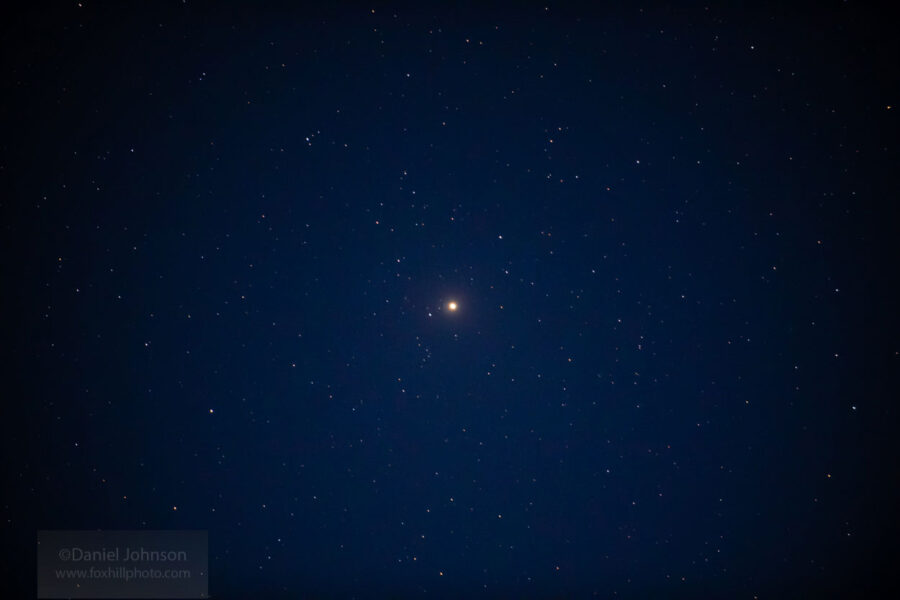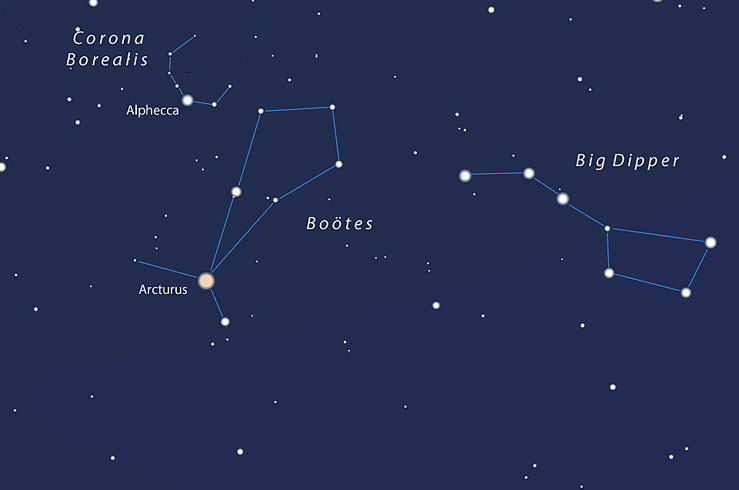Arcturus Vitals
| Official name | Arcturus |
| Other designations | Alpha Boötis, HIP 69673, HD 124897, HR 5340 |
| Nicknames | — |
| Apparent Magnitude | -0.05 |
| Distance from Earth | 36.7 light-years |
| Type | Red giant (K1.5III) |
| Color | Reddish orange |
| Mass | 1.0–1.5 M☉ |
| Radius | ~25 R☉ |
| Constellation | Boötes, the Herdsman |
| Right Ascension | 14h 15m 39s |
| Declination | +19° 10′ 56” |
| Multiple system? | Possibly |
| Variable star? | No |
| Exoplanet status | None known |
| Probable fate | Planetary nebula / white dwarf |
Physical Characteristics

Daniel Johnson
Arcturus is a fine example of a red giant star — impressively large, accordingly rarefied, brilliantly bright, and surprisingly cool. Arcturus possesses only slightly more mass than the Sun, but expands that material into a radius about 25 times larger.
As far as stars go, Arcturus is pretty close to us at only about 37 light-years away — appreciably more than the 4 or 8 light-years of Alpha Centauri or Sirius, respectively. But it’s much closer than the hundreds of light-years that separate us from other red giants such as Betelgeuse or Antares. This proximity to Earth is certainly a contributing factor to Arcturus’s apparent brightness. In fact, Arcturus is the fourth-brightest star in the night sky, outshone only by Sirius, Canopus, and Alpha Centauri, and the second brightest for much of the Northern Hemisphere.
Arcturus is a star on the move — it speeds along at about 122 km/s (273,000 mph). Because it’s so close to us, its proper motion, or movement on the sky, is fairly easy to detect: It amounts to about 2.3″ a year. With careful observation through a telescope, and a lot of patience, you can detect the star’s movement over the course of a few decades. Arcturus is also moving toward us, but that motion isn’t observable without a spectroscope.
Ancient astronomers held the view that the stars were fixed and immobile in the heavens — a reasonable assumption for observers without optical aid. You can thank the 18th-century astronomer Edmond Halley (of Halley’s Comet fame) for discovering the proper motion of Arcturus (and by implication, other stars). He did this by comparing the star’s position during his lifetime against records in the Almagest.
Origin / Mythology

Stellarium
Arcturus is a Greek name, and you’ll find a few different subtle translations of the meaning: “guardian of the bear,” “bear follower,” “keeper of the bear,” and others. All of these imply the same basic fact: Arcturus “chases” Ursa Major around the sky.
Of course, an alternate set of views depicts the Big Dipper section of Ursa Major as a plow — a common concept in the UK, for example. Mythology has a nice connection between Arcturus for that view as well. The star’s constellation, Boötes is the Herdsman — a farmer, in other words. In this case, Boötes the Herdsman becomes the man driving the plow. Presumably, oxen pull the plow but alas, we’re left to imagine that ourselves.
The concept of Arcturus “following” or “tending” the Big Dipper is widespread throughout the mythology of multiple cultures because Arcturus is close to the Big Dipper. In fact, if you “rewind the clock,” Arcturus moves even closer to the Dipper with each passing millennium.
Ancient cultures also put Arcturus to use as a navigational aid. Homer’s Odysseus sailed the Mediterranean with his eyes “fixed on . . . late-setting Boötes.” Polynesian sailors took advantage of the fact that Arcturus is a zenith star from Hawai‘i’s latitude, meaning that the star passes directly above the islands when at its highest point. Thus, they could use it to estimate their own latitude in relation to the archipelago.
How to See Arcturus
Daniel Johnson
Arcturus is a fine spring and summer star, riding high in the southwest around Summer Equinox. But it’s also a nice autumn star, hanging lower in the west just after sunset in the fall. The star’s brightness and obvious red color make it easy enough to find, but if you are in need of a handy guidepost, you can’t do better than by finding the Big Dipper and “Arcing to Arcturus.”
To do this, find the Big Dipper and take a look at the arc that is formed by the Dipper’s three handle stars (these would be Alioth, Mizar, and Alkaid). Then follow the direction of that curve until you run into Arcturus (it’s close but not perfect!). If Spica is above the horizon as well, you can then “Speed on to Spica,” if you’d like.
Because the Big Dipper is so prominent, the phrase is a handy method of locating Arcturus — and a great learning tool to teach others. The obvious orange color of Arcturus is also a good teaching moment; someone unfamiliar with astronomy may have never noticed that the stars come in a rainbow of colors.
Daniel Johnson is a Wisconsin-based freelance writer and professional photographer and the coauthor of over a dozen books. He’s a longtime amateur astronomer and fortunate enough to live in a rural region with excellent seeing conditions. You can view some of Dan’s photography (he does a lot of animals!) at www.foxhillphoto.com.